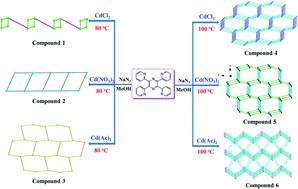Anion- and temperature-dependent assembly, crystal structures and luminescence properties of six new Cd(ii) coordination polymers based on 2,3,5,6-tetrakis(2-pyridyl)pyrazine†
Abstract
Solvothermal reactions of 2,3,5,6-tetra(2-pyridyl)pyrazine (tppz) and sodium azide with different cadmium salts including CdCl2·2.5H2O, Cd(NO3)2 and Cd(CH3COO)2·2H2O at 80 °C produce three new coordination polymers, namely, {[Cd2(N3)2(tppz)Cl2]·2H2O}n (1), [Cd2(N3)2(tppz)(NO3)2]n (2) and {[Cd2(N3)2(tppz)(CH3COO)2]·2H2O}n (3), respectively. Single-crystal X-ray diffraction analysis reveals that the anions of the Cd(II) salts all participate in coordination in compounds 1–3. Compound 1 features an infinite one-dimensional (1D) chain with loops-and-rods topology, compound 2 exhibits a 1D ladder-like chain, while compound 3 possesses a 2D honeycomb-like network structure with (6,3) topology. The low-dimensional structures of compounds 1–3 are further stabilized by diverse supramolecular interactions such as hydrogen bonds and π⋯π stacking. Interestingly, when the temperature is increased to 100 °C, similar reactions of tppz and sodium azide ligands with CdCl2·2.5H2O, Cd(NO3)2 and Cd(CH3COO)2·2H2O lead to three other novel 3D Cd(II) coordination polymers formulated as [Cd3(N3)6(tppz)]n (4), {[Cd2(N3)2(tppz)(NO3)2]·MeOH}n (5) and [Cd4(N3)6(tppz)(CH3COO)2]n (6), respectively. The anions of the Cd(II) salts again take part in coordination in compounds 5 and 6 but disappear in the final structure of 4. Compound 4 displays a rare sxd-type 3D framework with the Schläfli symbol of (33·46·55·6) if each V-shaped trinuclear [Cd3(μ1,1-N3)4] secondary building unit (SBU) is regarded as a 6-connected node. In compound 5, both the Cd1 and Cd2 atoms serve as 3-connected nodes to construct an uncommon binodal (3,3)-connected 3D framework with (6·102)(62·10) topology. Compound 6 contains another type of V-shaped trinuclear [Cd3(μ1,1-N3)2(μ3-CH3COO)] SBU, which acts as a 7-connected node to fabricate a unique uninodal 7-connected 3D framework with a completely new topology of (36·42·510·63). The present results reveal that both anions and temperature play essential roles in the structural and topological diversity of such six new Cd(II) coordination polymers. Moreover, the IR spectra, thermogravimetric analysis curves, and solid-state luminescence properties of all the compounds have been also investigated. Compared with the free tppz ligand, compounds 1–6 exhibit superior luminescence properties with largely enhanced emission, indicating that they may be good candidates for optical materials.


 Please wait while we load your content...
Please wait while we load your content...